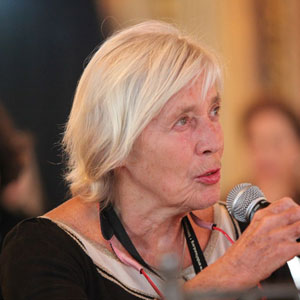Endometriosis Foundation of America 2014
Myths and Realities of Endometriosis Today and Tomorrow
- Liselotte Mettler, MD, PhD
I address you today as the first speaker in this political session. We will see how political it is. I would like to give an overview of this endometriosis tissue that we have wonderfully seen in Tamer’s video, how it can act and in what manner it can produce endometriosis.
In this picture you see the genital tract distorted – ovarian cysts. You see deep infiltrating endometriosis. You see deep infiltrating endometriosis on the bottom and you see that the genital tract is distorted. In many countries we have now in March 2014 Endometriosis Awareness Month and there are runs as was mentioned in Washington. There are different activities going on. At the end of this month we are meeting in Brazil and in many parts of the world people are aware that endometriosis is a challenge for the patients, for the doctors, for society, for all surrounding for politicians, for ethics, for everywhere.
In Germany I work in the European League of Ask the Experts if you have a problem with endometriosis. When we work in this internet forum we always get 30 to 40 questions daily to answer. We do that about one month a year. The patients have desperate questions to ask the experts on the internet because evidently their doctors do not convey the message to them. They cannot find the solutions to their problems. That is why also many societies try to create awareness for endometriosis for the disease that we have expressed and explained with all the previous speakers. We have the run in Washington, we have in Copenhagen an action, we are going to have in Berlin an action so many people are trying to create awareness of this disease.
In this photo on the left side, up in the corner, Tamer Seckin and Lone Hummelshøj who has done a lot to make us aware of this disease and of course there are many other people around the world that do that. We evaluated it in the background of endometriosis study, a larger group of patients with one of the classifications – this is our endoscopic endometriosis classification according to the disease and the impact. This would be stage one, light endometriosis between the bladder and the uterus. Stage two, like the ovaries sticking to the pelvic sidewall you can imagine like the lecture you heard from Linda of how this inflammation comes about and how it can be painful. We have heard about endometriotic cysts, we have heard about deep infiltrating endometriosis and how the bowel is affected and pulled up high on the uterine wall and how difficult pain actions can result from that for the patients.
The Enzian classification of the Austrian Alps group I have worked with for the last six years, we meet once a year, we try to make a good classification intraoperatively how deep the disease enters and we find at second look operations then results. We do not want to go into details of this surgery because we have many people in the audience who do not do surgery but it is a very deep and lacerating surgery to the surrounding organs, here we are over the bladder, here we free the ureter. We have to think of how much help it is to the patients. I do not agree with the statement of Victor but of course we did not really have time to discuss that and we will do that later that surgery is the solution. Maybe he wanted to say that it is just a momentary solution because endometriosis is a disease that has to be covered from other sides as well. We have so many patients that we cannot help with surgery.
If we have a patient with deep infiltrating endometriosis what do we do? First we have to find out how and to which organ is the endometriosis infiltrating? The rectal wall, does it go into the bladder, does it go to the sidelines to really determine how to go about surgery. That takes a long time. If we treat endometriosis we can have the concept of wait and see, we can say we will make a surgical diagnosis and excisional treatment which is perfect to do, or we can say it is better to do a conservative medical treatment. So the discussion of how to proceed is difficult and many patients sitting here may have received both treatments and still have not been helped. That is why we should never stop and say there is nothing we can do. We know it is a lifelong management plan that we have to give to the patients which includes various aspects.
Surgical treatment is one of the facts to consider, the excision for instance of endometriomas. Here is a summary of 560 patients that we did endometrioma excision looking at pre and post-operative pain. We find different results absence of pre-operative pain correlated with better post-operative results. So we evaluated these patients in different categories and we found that absence of pre-operative dysmenorrhea correlated with prognostically better post-operative results. We found that larger cyst size, younger age at surgery and pre-operative cyst rupture were associated with higher recurrence of endometrioma.
There is no advantage of combined therapy in preventing remission was found in this…over 500 patients. I just show these slides to show you that there is in some ways a good answer with surgery and some ways no good an answer. Surgical therapy exclusively led to longer post-operative recurrence free survival rate, which…is important if we see that on the patients.
The highest pregnancy rates occurred after combined surgical and hormonal treatment. That is also interesting from the infertility aspect. Malignant degeneration we found the same percentage was described about 0.4 percent in this…evaluation of our patients with endometrioma. In two of our cases only endometriomas in younger age correlated with the current study situation, other factors could not be confirmed.
We did have to conclude that the surgical aspect alone cannot really help all the patients. We recently did a study published in the Journal of Minimally Invasive Gynecology last year combining surgical, hormonal and surgical therapy and hormonal therapy alone. In a big randomized trial of 523 patients just the patients are consented to be taking part in this study and we compared these three groups and concerning live birth for example we found no statistical significant differences. However, the surgical and hormonal group was a little bit better.
This study showed us that we could help a larger percentage of patients to get rid of endometriosis but 20 to 30 percent of the patients not. Looking to the symptoms they were improved, best in surgical and hormonal combined treatment group after evaluating the patients two months after finishing both treatments. This is for pure endometriosis.
Now looking into adenomyosis, which we have not really mentioned today, is the penetration of growths of endometrial tissue from the uterine lining into myometrium. This brings up other problems because we can only excise to a certain extent these tissues and patients that really have adenomyosis in the uterus only a hysterectomy would help. But patients that want to have children cannot have a hysterectomy so there has to be found an intermediate action.
Conservative – uterine preserving surgery involving endometrial ablation, laparoscopic myometrial electrocoagulation or excision has proven to be effective in many patients – concerning their pain situations sometimes Chinese medicine or acupuncture helps.
I would also like to mention the medical approach to treatment. If we think about a medical approach in this political discussion, what is better, what helps, how it can be helped together we can again say we can just use analgesia, suppression of ovulatory function, which of course as we mentioned does not help for infertility patients, direct action of endometrial implant and modulation of the immune system and vascular system.
To just briefly go through the medical treatment for those unfamiliar with this we have no treatment, non-hormonal drugs, oral contraceptive pills, progesterone, Danazol, GnRH analogues with add back therapy and newer drugs like Visanne. We have the classical NSAIDs, aspirin, COX1 and COX2. What we want to achieve is actually within the therapeutic window which is acting best for our patients. And it is important to know no pain is permanent and never give up. Never tell a patient you cannot help her but always be ready with one of the other strategies. That is very important to convey to our patients.
The end point of medical treatment as well has to be the pain control, restoration of fertility and prevention of recurrence.
Choosing a treatment also depends upon the age of the patients, associated infertility, associated pain and recurrence. Other drugs have been given, specific conditions can be considered with the intra-uterine spirals, newer drugs aiming at hormonal targets, aromatase inhibitors and other selective estrogen, progesterones, progesterone agonists and recently we are giving Visanne again progesterone that is agonist that is helping quite well in many of our patients.
In my third section I come to the topic of pain, dyspareunia. In a previous lecture it was explained to us how pain can come about. If you look at the literature you will find a lot of descriptions of colleagues that have accumulated how the endometriosis patients really suffer, especially deep dyspareunia of pain, bladder, adnexal, bowel and endometriomas, all can produce pain. Women with endometriosis have a ninefold increase in risk of experiencing these symptoms compared with the general female population. If you just think about that it has to be understandable to the doctors and society that these patients need special support.
An endometriosis on the cervix has to be checked on the biological, psychological and physical tension it creates. We have to see what this dyspareunia can bring about. If you look at this evaluation of fertility and sterility done nearly ten years ago the endometriosis group, group U, has a global sexual satisfaction index much lower than normal patients or patients with endometriosis that are not deep infiltrating.
Vercellini, our present president of the World Endometriosis Society has published, “I Can’t Get No Satisfaction: deep dyspareunia and sexual functioning in women with rectovaginal endometriosis”. This has been described by so many of our colleagues. Seventy-eight percent of patients had sexual dysfunction. Thirty percent had sexual dysfunction and sexual distress. So pain is a very urgent issue to think about in the assessment and treatment of endometriosis patients. The prevalence of female sexual dysfunction was 73 percent in a Chinese paper so it is not only in America and Europe. In every country there are patients suffering from this.
Sexuality and endometriosis in endometriosis patients is described as one leading to continuous deep dyspareunia, previous experience of coital pain, altered awareness of pain and difficulty for the patient in their daily and marital life. Interstitial cystitis as an example continues to…as described by Maurice Chung in an evaluation of 178 patients, is a symptom that is putting patients in a difficult situation in their jobs, schools, wherever they are age-wise. Depressive symptoms – we have heard about this hysteria from older times and some patients may need some additional treatment to help them tolerate these symptoms. Eight-six point five percent presented with depressive symptoms as described here in this journal and 87.5 percent presented with anxiety. We find it everywhere and we have to help the patients to accept, treat and to live with the situation.
Complications at surgery do occur we know that. And of course that is why surgery has to be balanced with medical treatment. What is the strategy to take? That is up to the group of doctor and patient and field where she is working to decide what best helps her. A comparison of different symptoms of using medical and surgical therapy shows that we end up mostly at the same level and that really we do not have preference of one or the other.
Interaction between endometriosis and endometriosis-associated pain is complex. Deep dyspareunia is only a part of the global sexual function, especially in endometriosis. The high incidence of sexual dysfunction in endometriosis patients is underestimated. Long time social consequences for partner and relationship are largely unknown. Psychopathology may increase endometriosis associated pain and sexual dysfunction. And there are few evidences that surgery/medical treatment improve global sexual function.
What do we require of our patients – family understanding, true compassion for the individual woman, family comprehension of the biological part of the disease, social and political understanding of our society in this vicious cycle of pain and life disruption. Try to understand them, give them hope and do not leave them alone and relate openly in work and employment and in all kinds of situations.
How did I really understand endometriosis? I have not suffered it. But I have carefully observed my doctor/student PhD student Andrea. She came as a good looking blonde German student who had just graduated from medical school and had entered a doctor thesis. She was first diagnosed with endometriosis stage one, after a long, long dysmenorrhea. She had continuous pain after laparoscopy and was referred to surgeons. They did a bowel resection. She had three operations and was mentally going down, down, down. She did not finish her thesis, her marriage broke down and I followed up with her after five years. I had not seen her and I found that she had been left alone. Many of these patients need someone to help them if they drop out of the social field because of pain. It is very important that we are there for them at the right time.
Here you see this picture again where people are trying to help with endometriosis in different societies – surgical, medical and psychiatric, neurosurgical, everywhere we go.
I would like to end my lecture telling you politics that we also need to have love and understanding. I just want to bring you my understanding for America and for the future of love again in old age. I had a partner from 1966 to 1968 whom I only married in 2010. That is the story of a book that we also brought out “Long – Long Ago”. I met John when I was a young girl and I re-met him 45 years later. So just to say life is never lost. We both had good lives but we met again and he made this poem for me: Long, long ago, I saw you sitting there with your beautiful face and smile, and lovely golden hair. I asked permission to sit down, and wondered what you’d say. Across your face came a slight frown but your smile said please stay. There was a connection from the very start, as strange as that may be. There was a touching deep with the heart, and “knowing” of rarity. Fate closed our book for a period of time (45 years), later to be reopened and rewritten line by line. When I saw you again, the connection was still there. I knew in my heart there was love and there was care. Here is a photo of us when I was 25 years old and then I married this man. So love can come any time again. I do hope also for our endometriosis patients. Greeting from my city of Kiel on the Baltic in northern Germany.
We are all going to go to Brazil with our upcoming president Linda chairing the session to deal further with endometriosis with our patients. We are also going to meet in Berlin in March 2015 at the next World Congress of Human Reproduction dealing very much with endometriosis.
Please remember that life is like sailing, it is never in a straight line. Thank you very much.










